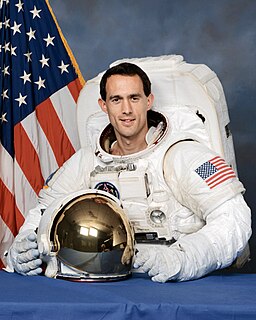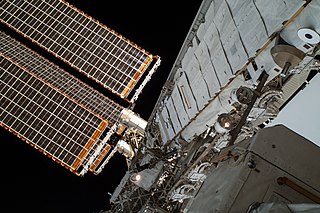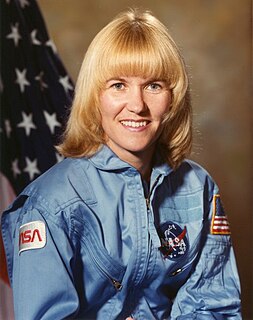
Jerry Lynn Ross is a retired United States Air Force officer, engineer and a former NASA astronaut. He is a veteran of seven Space Shuttle missions, making him the joint record holder for most spaceflights. His papers, photographs and many personal items are in the Barron Hilton Flight and Space Exploration Archives at Purdue University. He was inducted into the Astronaut Hall of Fame during ceremonies in May 2014.

STS-61-B was NASA's 23rd Space Shuttle mission, and its second using Space Shuttle Atlantis. The shuttle was launched from Kennedy Space Center, Florida, on November 26, 1985. During STS-61-B, the shuttle crew deployed three communications satellites, and tested techniques of constructing structures in orbit. Atlantis landed at Edwards Air Force Base, California, at 16:33:49 EST on December 3, 1985, after 6 days, 21 hours, 4 minutes, and 49 seconds in orbit.

STS-37, the thirty-ninth NASA Space Shuttle mission and the eighth flight of the Space Shuttle Atlantis, was a six-day mission with the primary objective of launching the Compton Gamma Ray Observatory (CGRO), the second of the Great Observatories program which included the visible-spectrum Hubble Space Telescope (HST), the Chandra X-ray Observatory (CXO) and the infrared Spitzer Space Telescope. The mission also featured two spacewalks, the first since 1985.

STS-49 was the NASA maiden flight of the Space Shuttle Endeavour, which launched on 7 May 1992. The primary goal of its nine-day mission was to retrieve an Intelsat VI satellite, Intelsat 603, which failed to leave Low Earth orbit two years before, attach it to a new upper stage, and relaunch it to its intended geosynchronous orbit. After several attempts, the capture was completed with the only three-person extravehicular activity (EVA) in space flight history. It would also stand until STS-102 in 2001 as the longest EVA ever undertaken.

STS-112 was an 11-day Space Shuttle mission to the International Space Station (ISS) flown by Space ShuttleAtlantis. Space Shuttle Atlantis was launched on 7 October 2002 at 19:45 UTC from the Kennedy Space Center's launch pad 39B to deliver the 28,000 pound Starboard 1 (S1) truss segment to the Space Station. Ending a 4.5-million-mile journey, Atlantis landed at 15:44 UTC on 18 October 2002 on runway 33 at the Kennedy Space Center's Shuttle Landing Facility.

STS-72 was a Space Shuttle Endeavour mission to capture and return to Earth a Japanese microgravity research spacecraft known as Space Flyer Unit (SFU). The mission launched from Kennedy Space Center, Florida on 11 January 1996.

James Hansen Newman, Ph.D. is an American physicist and a former NASA astronaut who flew on four Space Shuttle missions.

Scott Edward Parazynski is an American physician and a former NASA astronaut. A veteran of five Space Shuttle flights and seven spacewalks, Parazynski's latest mission was STS-120 in October, 2007 – highlighted by a dramatic, unplanned EVA to repair a live solar array. In May 2016 he was inducted into the United States Astronaut Hall of Fame. He retired from NASA in March 2009 to pursue entrepreneurial opportunities in the private sector, and he is currently the CEO of a technology start-up. He is the first person to have both flown in space and summited Mount Everest, the highest point on Earth.

Sherwood Clark Spring is a retired United States Army colonel and former NASA astronaut. Spring is married with two children. He is the father of United States Olympian Justin Spring. Sherwood Spring has logged 165 hours in space, 12 of which were spent conducting spacewalks. Spring has also accumulated 3,500 hours in 25 different military and civilian aircraft; over 1,500 of those hours were spent in jet aircraft.

Peter Jeffrey Kelsay Wisoff is an American physicist and former NASA astronaut. Wisoff qualified as mission specialist and flew in four Space Shuttle missions, with his first launch in 1993 and his last in 2000.

John Daniel "Danny" Olivas is an American engineer and a former NASA astronaut. Olivas has flown on two space shuttle missions, STS-117 and STS-128. He performed EVAs on both missions, totaling 34hrs 28min.

The Space Systems Laboratory (SSL) is part of the Aerospace Engineering Department and A. James Clark School of Engineering at the University of Maryland in College Park, Maryland. The Space Systems Laboratory is centered on the Neutral Buoyancy Research Facility, a 50-foot-diameter (15 m), 25-foot-deep (7.6 m) neutral buoyancy pool used to simulate the microgravity environment of space. The only such facility housed at a university, Maryland's neutral buoyancy tank is used for undergraduate and graduate research at the Space Systems Lab. Research in Space Systems emphasizes space robotics, human factors, applications of artificial intelligence and the underlying fundamentals of space simulation. There are currently five robots being tested, including Ranger, a four-armed satellite repair robot, and SCAMP, a six-degree of freedom free-flying underwater camera platform. Ranger was funded by NASA starting in 1992, and was to be a technological demonstration of orbital satellite servicing. NASA was never able to manifest it for launch and the program was defunded circa 2006. For example, Ranger development work at the SSL continues, albeit at a slower pace; Ranger was used to demonstrate robotic servicing techniques for NASA's proposed robotic Hubble Servicing Mission.

The Neutral Buoyancy Laboratory (NBL) is an astronaut training facility and neutral buoyancy pool operated by NASA and located at the Sonny Carter Training Facility, near the Johnson Space Center in Houston, Texas. The NBL's main feature is a large indoor pool of water, in which astronauts may perform simulated EVA tasks in preparation for upcoming missions. Trainees wear suits designed to provide neutral buoyancy to simulate the microgravity that astronauts would experience during spaceflight.

Andrew Jay "Drew" Feustel is an American/Canadian NASA astronaut and geophysicist. Following several years working as a geophysicist, Feustel was selected as an astronaut candidate by NASA in July 2000. He is the veteran of 3 space flights with NASA. His first spaceflight in May 2009, STS-125, lasted just under 13 days. This was a mission with six other astronauts to repair the Hubble Space Telescope, aboard Space Shuttle Atlantis. Feustel performed three spacewalks during the mission. His second spaceflight was STS-134, which launched on May 16, 2011, and landed on June 1, 2011. STS-134 was the penultimate Space Shuttle flight. Feustel returned to space on March 21, 2018, on Soyuz MS-08 with Expedition 55/56. For expedition 56, he commanded the International Space Station, before handing over to Alexander Gerst on October 3, 2018.

The Integrated Truss Structure (ITS) of the International Space Station (ISS) consists of a linear arranged sequence of connected trusses on which various unpressurized components are mounted such as logistics carriers, radiators, solar arrays, and other equipment. It supplies the ISS with a bus architecture. It is approximately 110 meters long and is made from aluminum and stainless steel.

The Neutral Buoyancy Simulator was a neutral buoyancy pool located at NASA's George C. Marshall Space Flight Center (MSFC). Engineers and astronauts developed hardware and practiced procedures in this tank from its completion in 1968 through its decommissioning in 1997. Marshall recognized the need for underwater simulations of extra-vehicular activities (EVAs) and developed three successively larger tanks for the purpose. The Neutral Buoyancy Simulator contributed significantly to the American crewed space program. Skylab, the Space Shuttle, Hubble Space Telescope, and the International Space Station have all benefited from the Neutral Buoyancy Simulator. Until Johnson Space Center constructed the Weightless Environment Test Facility in the mid-1970s, MSFC had the only NASA-owned test facility that allowed engineers and astronauts to become familiar with the dynamics of body motion under weightless conditions.

Neutral buoyancy simulation with astronauts immersed in a neutral buoyancy pool, in pressure suits, can help to prepare astronauts for the difficult task of working while outside a spacecraft in an apparently weightless environment.

Astronaut training describes the complex process of preparing astronauts in regions around the world for their space missions before, during and after the flight, which includes medical tests, physical training, extra-vehicular activity (EVA) training, procedure training, rehabilitation process, as well as training on experiments they will accomplish during their stay in space.

A neutral buoyancy pool or neutral buoyancy tank is a pool of water in which neutral buoyancy is used to train astronauts for extravehicular activity and the development of procedures. These pools began to be used in the 1960s and were initially just recreational swimming pools; dedicated facilities would later be built.

Mary Helen Johnston, later also Mary Helen McCay, is an American scientist and former astronaut. Working with NASA as an engineer in the 1960s and '70s, Johnston aspired to be an astronaut; she unsuccessfully applied in 1980 before becoming a payload specialist in 1983. Johnston retired from NASA in 1986 without having gone to space. She is a professor at Florida Institute of Technology.






















